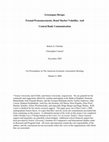Papers by Christopher Curran

Asia Pacific Journal of Tourism Research, Feb 2, 2007
Sex and sexuality are powerful human emotions that have been exploited by the tourism industry to... more Sex and sexuality are powerful human emotions that have been exploited by the tourism industry to develop aspects of destination image. Where destinations have sought to exploit sex by use of the erotic as an appealing image, sex becomes a featured selling point and may inadvertently become more important than other elements of the destination's preferred image as a result of image capture where the preferred image is displaced by a less preferred image. This paper examines the potential for image confusion when the erotic is used alongside the exotic as part of destination image. In particular, Thailand's preferred image as an exotic destination and the nation's unofficial image as a location for erotic activities are considered. Marketing implications are examined, as are potential measures that may be implemented to soften or even eliminate potentially negative impacts that are presently associated with Thailand's reputation as a center for sex tourism.

International Review of Law and Economics
This paper analyzes the impact of FORIS contracts on litigation and settlement decisions using a ... more This paper analyzes the impact of FORIS contracts on litigation and settlement decisions using a simple divergent-expectations model. A FORIS contract introduces contingent fee arrangements under the British legal cost allocation rule: the plaintiff pays a percentage of his settlement or trial returns to FORIS and obtains coverage for trial costs in case he loses in court; the plaintiff?s attorney receives the standard fee. We take into account the sequential nature of the settlement and trial decisions. Without FORIS contracts, only cases with positive expected value provide credible threats for the plaintiff and thereby motivate the defendant to agree to a settlement. A FORIS contract has two important effects: cases with negative expected value are turned into credible threats, hence a settlement is triggered. Even in positive expected value cases, the settlement result for the plaintiff is increased. According to our results, FORIS should prohibit settlement negotiations before ...
The Journal of Law and Economics
Recent changes in real estate law hastened the shift from a seller's agency regime, in which ... more Recent changes in real estate law hastened the shift from a seller's agency regime, in which real estate agents serve the interests of sellers, to a buyer's agency regime, in which agents serve the interests of buyers. Using data from the Atlanta real estate market, we show that the shift to buyer's agency led to a significant decline in real estate prices in the market for relatively expensive houses, while real estate prices did not significantly change in the market for relatively inexpensive homes. In both markets, the average time needed to sell a house fell after the change in agency regimes. These results are consistent with a conclusion that a shift to buyer's agency improves the efficiency of the search process. Copyright 2000 by the University of Chicago.

This paper presents empirical evidence on one aspect of central bank communication policy - forma... more This paper presents empirical evidence on one aspect of central bank communication policy - formal pronouncements by central bankers - to better understand whether this channel matters and, if so, the nature of the information being transmitted. We examine the relationship between three types of pronouncements from Chairman Alan Greenspan - speeches, testimonies, and FOMC meetings (STF’s) - and volatility in the 30-year U.S. Treasury bond futures market. Using high-frequency, intraday data proves important in uncovering the impacts of pronouncements on the bond market. Three questions relevant to central bank communication policy are addressed (see Figure 1 for a summary). We find that STF’s matter for bond market volatility, that this impact depends on the transmission of information (rather than just noise), and that this information reflects both substantive content and a coordinating signal. We further find that speeches only deliver content, that testimonies are largely a coord...

SSRN Electronic Journal
This paper presents empirical evidence on one aspect of central bank communication policy - forma... more This paper presents empirical evidence on one aspect of central bank communication policy - formal pronouncements by central bankers - to better understand whether this channel matters and, if so, what is the nature of the information being transmitted. We examine the relationship between three types of pronouncements from Chairman Alan Greenspan - speeches, testimonies, and FOMC meetings - and volatility in the 30-year U.S. Treasury bond futures market. By studying the reaction of financial markets, we are able to examine several interesting aspects of the nature of central bank communication policy. Three questions relevant to communication policy are addressed. First, Do these speeches, testimonies, and FOMC meetings (STF's) matter? We find a strong positive effect, thus rejecting the notions that STF's are a redundant communication channel or that the bond market is strong-form efficient. We also document that the FOMC meetings are the most potent STF. This systematic li...
Geneva Papers on Risk and Insurance - Issues and Practice
Metroeconomica
The purpose of this note is to develop two points concerning a positively sloped IS curve. First,... more The purpose of this note is to develop two points concerning a positively sloped IS curve. First, the stability condition for the IS-LM macroeconomic system is shown to be satisfied when both the government expenditure and money multipliers are positive. Since theoretical and empirical work indicate that both multipliers are positive, it is of interest to know that this insures macroeconomic stability. Second, an analogy between a Giffen good and an IS curve is drawn. In particular, it is shown that just as a necessary condition for a Giffen good is that quantity demanded and income be negatively related in the demand function, similarly a necessary condition for a positively sloped IS curve is that income and government expenditure be negatively related in the IS function.
We compare a seller's agency regime, in which agents give sellers information about buyers... more We compare a seller's agency regime, in which agents give sellers information about buyers' willingness to pay, with a buyer's agency regime, in which agents keep buyers' information confidential. Aggregate gains from trade can be higher under either agency regime. Aggregate gains from trade are higher under buyer's agency if traders expect to spend less time in the market under buyer's agency. Equivalently, aggregate gains from trade are higher under seller's agency only if traders expect to spend less time in the market under seller's agency. We use our theoretical results to interpret empirical findings on the effects of different agency regimes.

SSRN Electronic Journal, 2000
This paper presents empirical evidence on one aspect of central bank communication policy -formal... more This paper presents empirical evidence on one aspect of central bank communication policy -formal pronouncements by central bankers -to better understand whether this channel matters and, if so, what is the nature of the information being transmitted. We examine the relationship between three types of pronouncements from Chairman Alan Greenspan --speeches, testimonies, and FOMC meetings --and volatility in the 30-year U.S. Treasury bond futures market. We focus on this market because of its sensitivity to monetary policy pronouncements, its substantial effects on real spending, its long-standing establishment (at that time) as the benchmark long-term Treasury security, its depth, and the availability of market prices at fiveminute intervals. By studying the reaction of financial markets, we are able to examine several interesting aspects of the nature of central bank communication policy.
SSRN Electronic Journal, 2000
To change the law, an interest group must choose between lobbying the legislature and litigating ... more To change the law, an interest group must choose between lobbying the legislature and litigating for new precedent. Lobbying becomes more likely as the relative benefits from rule change become greater, as the costs of lobbying become smaller and as the voting strength of the interest groups becomes larger. Litigating becomes more likely as trial costs fall, as the relative benefits from rule change become greater, as the inclination of courts to change existing precedents increases, and as the interest group is involved in more trials. Examples of using a litigating strategy include the NAACP is its battle for racial integration and attorneys seeking change in tort law. Business, in resisting changes to tort law, has used the judicial process. The nature of equilibrium, if any, is not clear.
The Journal of Law and Economics, 2000
Recent changes in real estate law hastened the shift from a seller's agency regime, in wh... more Recent changes in real estate law hastened the shift from a seller's agency regime, in which real estate agents serve the interests of sellers, to a buyer's agency regime, in which agents serve the interests of buyers. Using data from the Atlanta real estate market, we show that the shift to buyer's agency led to a significant decline in real
The Journal of Economic History, 1979
THIS paper examines the role of the Bank War in the economic events of the 1830s by developing an... more THIS paper examines the role of the Bank War in the economic events of the 1830s by developing and testing a structural economic model of the financial sector of the antebellum United States economy. By the Bank War I mean those political and economic events which occurred ...
Legal scholars have often argued that a legal system in providing a 'level playing field... more Legal scholars have often argued that a legal system in providing a 'level playing field' for consumers and producers should be designed to help in society's efforts to achieve an optimal distribution of income. This chapter reviews research by law and economics scholars that challenges this premise. Using neoclassical welfare economics most of these scholars conclude that there exists a taxation scheme that achieves a desired income distribution and is preferred by all members of society to any plan for redistributing income using the legal system. An implication of this research is that economic efficiency and not fairness is the appropriate criteria for evaluating any legal rule. JEL classification: K0, H2
Metroeconomica, 1978
The purpose of this note is to develop two points concerning a positively sloped IS curve. First,... more The purpose of this note is to develop two points concerning a positively sloped IS curve. First, the stability condition for the IS-LM macroeconomic system is shown to be satisfied when both the government expenditure and money multipliers are positive. Since theoretical and empirical work indicate that both multipliers are positive, it is of interest to know that this insures macroeconomic stability. Second, an analogy between a Giffen good and an IS curve is drawn. In particular, it is shown that just as a necessary condition for a Giffen good is that quantity demanded and income be negatively related in the demand function, similarly a necessary condition for a positively sloped IS curve is that income and government expenditure be negatively related in the IS function.
Journal of Urban Economics, 1982
JOURNAL OF URBAN ECONOMICS 12, 102114 (1982) A Theory of Residential Location Decisions of TwoWor... more JOURNAL OF URBAN ECONOMICS 12, 102114 (1982) A Theory of Residential Location Decisions of TwoWorker Households1 CHRISTOPHER CURRAN AND LEONARD A. CARLSON Department of Economics, Emory University, Atlanta, Georgia 30322 AND DAVID A. FORD ...
Journal of Regional Science, 1974

International Review of Law and Economics, 1992
ABSTRACT This paper analyzes the impact of FORIS contracts on litigation and settlement decisions... more ABSTRACT This paper analyzes the impact of FORIS contracts on litigation and settlement decisions using a simple divergent-expectations model. A FORIS contract introduces contingent fee arrangements under the British legal cost allocation rule: the plaintiff pays a percentage of his settlement or trial returns to FORIS and obtains coverage for trial costs in case he loses in court; the plaintiff?s attorney receives the standard fee. We take into account the sequential nature of the settlement and trial decisions. Without FORIS contracts, only cases with positive expected value provide credible threats for the plaintiff and thereby motivate the defendant to agree to a settlement. A FORIS contract has two important effects: cases with negative expected value are turned into credible threats, hence a settlement is triggered. Even in positive expected value cases, the settlement result for the plaintiff is increased. According to our results, FORIS should prohibit settlement negotiations before a contract with the plaintiff has been made. The paper argues that FORIS should abolish the non-disclosure clause which prohibits the plaintiff to reveal the existence of the FORIS contract to a third party. -- Das Paper analysiert die Wirkung eines FORIS-Vertrages auf die Bereitschaft zu klagen und zum au�ergerichtlichen Vergleich. Dabei wird ein einfaches Optimismus-Modell angewendet. Der FORIS-Vetrag erlaubt es dem Kl�ger, trotz Geltung der Europ�ischen Proze�kostenregel (Velierer zahlt) mit den (in Amerika �blichen) "contingent fees" kalkulieren zu k�nnen: Der Kl�ger zahlt einen Teil seiner Ertr�ge aus Proze� oder Vergleich an FORIS; diese Firma wiederum zahlt die gesetzlichen Geb�hren an den Anwalt des Kl�gers und tr�gt die Proze�kosten, wenn der Kunde unterliegt. Das Modell zieht die sequentielle Struktur von Vergleichs- und Proze�entscheidungen in Betracht. Ohne FORIS-Vertrag w�re eine Klagedrohung nur dann glaubw�rdig, wenn der Proze� dem Kl�ger einen p
European Journal of Education, 2001










Uploads
Papers by Christopher Curran